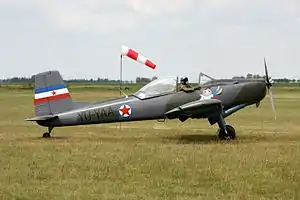Soko J-20 Kraguj
The Soko J-20 Kraguj (Sparrowhawk) is light military, single-engine, low-wing single-seat aircraft with a metal airframe, capable of performing close air support, counter insurgency (COIN), and reconnaissance missions, that was designed by VTI and manufactured by SOKO of Yugoslavia, first flown in 1962.
| J-20 Kraguj | |
|---|---|
 | |
| J-20 Kraguj in private collection with Yugoslav marks at a local airshow in Serbia, 2009. | |
| Role | COIN |
| Manufacturer | SOKO |
| Design group | Aeronautical Technical Institute |
| First flight | 21 November 1962 |
| Introduction | 1964 |
| Status | Retired in 1989 |
| Primary user | Yugoslav Air Force (1967-1989) |
| Produced | 1964-1977 |
| Number built | 43 |
Design
It is of classic semi-monocoque, metal structure with a slightly tapered wing. The pilot is accommodated in an enclosed, heated and ventilated cockpit with adjustable seats. The cockpit canopy slides backwards to open. The landing gear is non-retractable with a tail wheel. Rubber dampers provide shock absorption, and hydraulic brakes are used for wheel braking.
The power plant comprises one 340 hp Textron Lycoming GSO-480-B1J6 piston engine and Hartzell HC-B3Z20-1/10151C-5 three-blade metal variable-pitch propeller. The engine cooling airflow is intensified by means of two specially designed ejectors. 36 US Gal of fuel contained in two rubber tanks enables a flight range of 350 NM for the fully armed configuration of the aircraft. 28 V DC electric power is supplied from a 1,5 kW generator and a storage battery. De-fogging and de-icing of the windshield is done by blowing of hot air.
Armament
Permanent armament comprises two wing-mounted 7.7 mm Colt–Browning Mk-II machine guns with 650 rounds each and a collimator sight in the cockpit. For combat missions there is a capacity for an external load of bombs and two 57 mm and two 128 mm (HVAR-5) air-to-ground rocket launchers. Adapters on the underwing pylons can be used to switch the armament configuration from free-fall bombs to multi-tube launchers with twelve 57 mm air-to-ground rockets. Cluster or cargo bombs, or 128 mm air-to-ground rockets can be fitted.
Operation
The aircraft was specially designed for low-altitude missions against day and night visible ground targets in a broad area. It was readily available to be loaded with weapons and supplied through a flexible system of auxiliary airfields that required no special preparations, especially in mountainous regions. Yugoslav military planners assumed that potential aggressor will first disable airfields. Therefore, J-20 Kraguj was designed to take-off from short unprepared runways, even ones covered in deep snow when fitted with skis. It was also called a "Partisan aircraft".
The Kraguj P-2 was intended for close ground force support, and could be used for training of pilots in visual day/night flights, aiming, missile firing and bombing of ground targets.
Specifications (J-20)
Data from Jane's All the World's Aircraft 1969-70 [1]
General characteristics
- Crew: 1
- Length: 7.93 m (26 ft 0 in)
- Wingspan: 10.64 m (34 ft 11 in)
- Height: 3.00 m (9 ft 10 in)
- Wing area: 17.0 m2 (183 sq ft)
- Aspect ratio: 6:1
- Airfoil: NACA 4415
- Empty weight: 1,130 kg (2,491 lb)
- Max takeoff weight: 1,624 kg (3,580 lb)
- Fuel capacity: 240 L (53 imp gal; 63 US gal)
- Powerplant: 1 × Lycoming GSO-480-B1A6 6-cylinder air-cooled horizontally-opposed piston engine, 250 kW (340 hp)
- Propellers: 3-bladed Hartzell HC-B3Z20-1 constant-speed propeller, 2.44 m (8 ft 0 in) diameter
Performance
- Maximum speed: 295 km/h (183 mph, 159 kn) at 1,500 m (4,900 ft)
- Cruise speed: 280 km/h (170 mph, 150 kn) at 1,500 m (4,900 ft)
- Stall speed: 88 km/h (55 mph, 48 kn) (flaps down)
- Range: 800 km (500 mi, 430 nmi)
- Rate of climb: 8.00 m/s (1,575 ft/min)
- Take-off run to 15 m (50 ft): 189 m (620 ft)
- Landing run from 15 m (50 ft):: 324 m (1,063 ft)
Armament
- Guns: 2 × 7.7 mm Colt–Browning Mk.II machine guns (650 rounds each)
- Rockets: 2 × 12 round rocket pack or 6 × 57 mm or 127 mm rocket
- Bombs: 2 × 100 kg (220 lb) bombs
References
- J W R Taylor 1969, p.506.
- Taylor,John W.R. (editor). Jane's All The World's Aircraft 1969-70. London: Sampson Low,1969.
External links
| Wikimedia Commons has media related to Soko J-20 Kraguj. |
